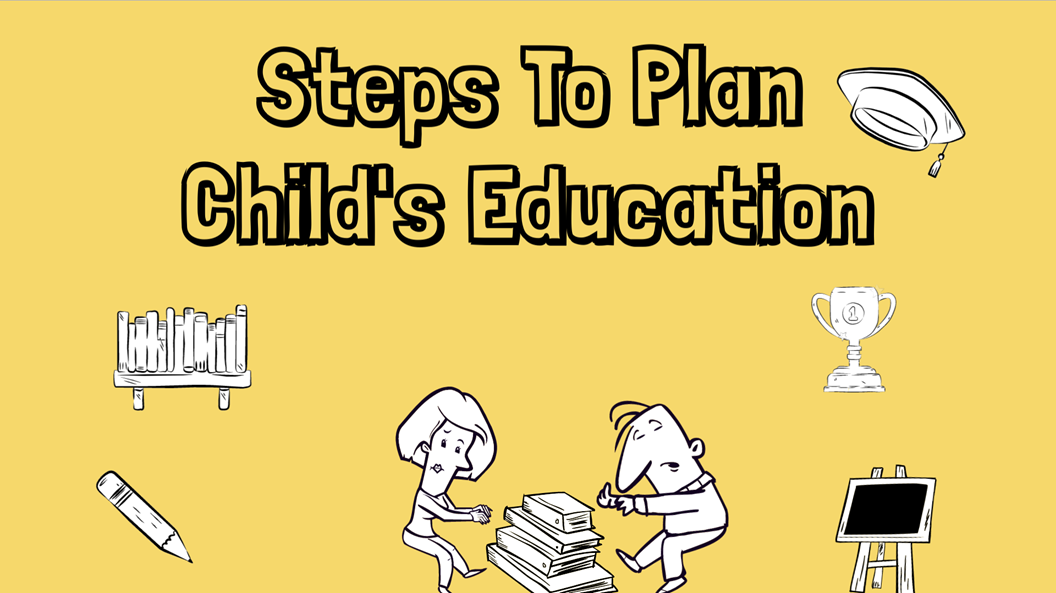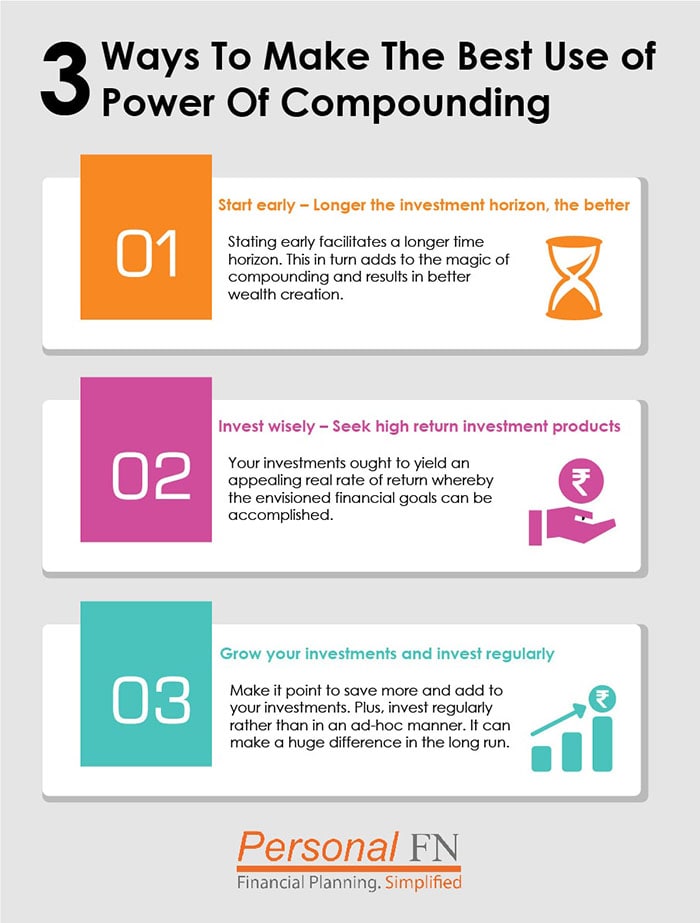Step-By-Step Approach To Plan Your Child's Education Needs

“Education is the key to unlocking the world, a passport to freedom” – Oprah Winfrey.
As parents, it is natural to want the very best for your child - the best schooling, best opportunities in life, etc. But you see, education is one of the best gifts your children can receive.
And as Indians, it is strongly ingrained in us that education is everything, and we want our kids to go to the top schools for their chosen fields.
Even though education is the most important priority for parents, the costs are a major concern. They shell out a large portion of their savings to provide the best education.
Hence, a financial plan to achieve this goal is very important.
If you already have children, the earlier you start planning, the better.
Especially if you want your child to attend good institutions and abroad. You must begin planning soon as the education costs are only on the rise.
Consider this example:
Mr Shah has a 3-year-old son, who will graduate in 15 years. Mr Shah wants his son to pursue engineering. If the cost of graduation in today's terms is Rs 5 lakh, let’s ascertain how much it will cost to send his son to engineering college in 15 years?
| Son's Age |
3 years |
| Cost of Education in today's terms |
Rs 5 lakh |
| Time left for Graduation |
15 years |
| Inflation Rate |
10% p.a. |
| Cost at time of Graduation course |
Rs 20.88 lakh |
| Amount Mr Shah needs to invest per month |
Rs 4,180 |
You see, as seen in the table above, the cost of education after 15 years will rise to Rs 20.88 lakh due to inflation. And to fulfil this goal, Mr Shah will have to invest Rs 4,180 per month, assuming he earns a return of 12% per annum.
However, if Mr Shah delays this investment, and begins to save for his son's education five years from now, the investment will be more than double, i.e. Rs 9,079 per month.
Similarly, to ensure your child receives the best education, you need to prepare yourself financially.
If you plan now, chances are you will not compromise on your child's future, his/her dreams, aspirations, and ambitions.
This is a guide to the 8-step investment plan towards your child's education with details illustrated in the following case study.
Step 1: Decide Your Time Horizon

Calculate the years to your child's graduation and post-graduation. With the approximate number of years in mind, you can decide the time horizon.
The longer the time-horizon, the better it is for you to plan and invest.
But do not wait till the last hour. Start investing for this goal at earliest.
Step 2: Estimate The Cost Of Education

The first thing you need to do is determine what is going to be the total cost of education for your child. This depends on various factors.
One of the things to ask yourself is; do you want your child to have a global exposure and education, or do you prefer to have your child remain closer to home?
This is to be considered alongside the second question - are there good schools in India/Abroad for the discipline your child is likely to choose?
Third, do you want your child to do the undergraduate and post-graduate courses abroad, or just the post graduate course?
Finally, what is the likely overall cash outflow in both cases?
And while calculating the total expense, it is important to determine the future cost of high school or college or the post-graduate course.
Suppose a business school charges Rs. 25 lakh today and your child will likely attend it in five years from today — @ 8% annual inflation, the fees would be Rs. 36.73 lakh.
And say if inflation is at 12% annual inflation; you would end up paying even higher, i.e. Rs. 44.05 lakh in five years. That's quite a difference. And planning to build a corpus of Rs. 44 lakh at one go may not be easy for everyone. So, be realistic about assuming the inflation factor and start planning early.
Conservatively, you can estimate 8-10% inflation on education.
Step 3: Assess Your Existing Assets and Liabilities

List down all your assets and liabilities to know where you stand today to plan accordingly. This can help you plan better.
For example, Mr Shah needs a corpus of Rs 1.20 crores for his son's education in three years' time. To achieve this corpus, if Mr Shah were to invest in debt (due to the risk involved in equities), his investment would be Rs 2.98 lakh per month in a debt mutual fund, earning 7% post-tax returns.
Is it feasible, considering Mr Shah has other goals that he also needs to invest for, the biggest one among these being his own retirement?
No.
Hence, he should first analyse any investments that have already been made which might help him to accumulate the desired corpus.
So, if Mr Shah has invested in his son's PPF account or diversified equity mutual funds or fixed deposits with a view of utilising these savings for his child's education, he must first assess the current value of these investments before making any further investments.
An important thing to bear in mind is that you must avoid dipping into the investments made for other financial goals, especially your retirement corpus, while planning for your child's education.
Also, you must also not dip into the investments made for your child's education for other low priority expenses such as renovating your home, etc.
Step 4: Know The Amount To Be Saved Now

Once you know the approximate cost of education. Decide how much you need to save now or a monthly contribution required to achieve this goal on or before time.
The easier way is to put aside some money towards each goal in a systematic manner. You can either opt for the Systematic Investment Plan in mutual funds or start a Recurring Deposit with bank. The idea is to put aside some money regularly to meet this goal.
Save and invest regularly so that you don't have to take loans, which can prove to be a costly proposition in the long run.
Try to save a larger proportion of your monthly income if your current savings are insufficient. If it's posing to be a challenge, the first thing you should do is reduce your household and personal expenses by snapping the unnecessary ones altogether or find an additional source of income.
Remember that savings alone might not help you achieve your target because the inflation bug eats into your savings and erodes their value.
Step 5: Plan Your Investments Smartly

Smartest way of investing is by designing asset allocation and investing accordingly.
Once you have made an account of the already existing investments which can be mapped towards your child's education, you might need to save and invest on a regular basis to fill in the gap.
You need to invest this hard-earned money in suitable investment avenues depending upon your asset allocation pattern and risk appetite to counter inflation and increase the value of your portfolio.
Make sure your asset allocation is just right to accomplish your child's education goal.
For an investment time horizon of greater than five years, clearly park the money in equity mutual funds as they have the potential to provide higher returns over the long run.
But as you near your goal, rebalance your investment portfolio gradually towards fixed income or debt.
A well-planned asset allocation scales up your portfolio returns exponentially. It can also act as a shield to protect its value during uncertain economic conditions and market volatility.
Step 6: Get Yourself Adequately Insured

Have you considered what will happen to your dream of giving your child the best possible education, in case you have an untimely death or meet with an accident that impedes your physical ability to earn?
One of the biggest potential setbacks to a child's education is the demise of the breadwinner in the family and the lack of insurance.
Ensure that you have enough life and health insurance to at least cover the tuition fees of the school and college your child will possibly attend.
You see, there are ways to achieve your family goals even in your absence.
But that can only happen if you have the right amount of insurance for your family's financial goals and regular expenses to still be met.
To know the appropriate amount of insurance cover you should have, you may use PersonalFN's Human Value Calculator (HLV) calculator.
Likewise, optimally insure for health. Not having an adequate medi-claim cover or one at all can potentially derail your financial goals if medical emergencies arise.
Read: Your Guide To Insurance
Step 7: Prepare Yourself For The Unexpected

Always prepare yourself for additional costs such as accommodation, pocket money, tuition fees, and so on.
Whenever your child enters high school, there might be many other expenses apart from school and tuition fees.
These other expenses may seem small, but when put together, they will add up to a huge figure. This is even more relevant in the case where you want your child to undertake any graduate or post-graduate courses overseas.
This is because when your child finally gets admission, you will probably find that there are a number of additional costs unaccounted for.
Right from flight tickets to food and accommodation, to pocket money and insurance, things will add up. But, this is manageable.
If possible, speak to parents of the alumni, or the alumni themselves and find out what the total cash outflow was for the duration of the course. This will give you an estimate on the potential expenditure.
Even after forecasting and planning for all of these expenses, it would be prudent to have some buffer for unforeseen expenses.
Step 8: Get Started Right Away

Last, but not the least, start now. The sure-fire way to not achieve your goal is procrastination.
If you save and invest early, you will have a longer time horizon to meet your goals and build a bigger corpus enabled by the power of compounding.

A Case Study of Mr & Mrs Kapoor
Mr & Mrs Kapoor want to secure the future of their son, Kunal, by providing him with the best education.
Here are their personal details….
| Personal Details |
| Name |
Age |
Income |
| Mr. Kapoor's Salary |
35 years |
Rs 100,000 per month |
| Mrs. Kapoor's Salary |
30 years |
Rs 80,000 per month |
| Son, Kunal |
3 years |
N.A. |
| Expenses |
Rs 70,000 per month |
| Surplus |
Rs 110,000 per month |
(For illustration purpose only)
Mr Sagar Kapoor, 35, a salaried individual earns Rs 100,000/month, while his wife, 30, also a salaried person, earns Rs 80,000/month. So, together their monthly income is Rs 180,000.
Their monthly expenses on the other hand are Rs 70,000, leaving them with a surplus of Rs 110,000 each month.
Their Assets Are:
| Assets |
| Sr. No. |
Type of Assets |
Amount (Rs) |
| 1 |
Equity Shares |
125,000 |
| 2 |
EPF (Self) |
200,000 |
| 3 |
EPF (Spouse) |
90,000 |
| 4 |
PPF (Self) |
500,000 |
| 5 |
PPF (Spouse) |
300,000 |
| 6 |
Residential Flat |
6000,000 |
| 7 |
Physical Gold |
1,000,000 |
| 8 |
Cash in Bank (Self) |
200,000 |
| 9 |
Cash in Bank (Spouse) |
100,000 |
| Total |
8,515,000 |
(For illustration purpose only)
Mr & Mrs Kapoor, fortunately, do not have any ‘liabilities’.
Assessment of the assets:
The residential flat comprised more than 50% of their total assets, and since it is self-occupied, cannot be used for planning purpose.
They had a small amount of investment in equities.
They have their individual EPF, PPF and cash in bank accounts.The Cash in Bank was mainly kept for contingency purpose.
The physical gold was mostly in jewellery.
Kunal's Education Goal
|
Current Cost (Rs) |
Time to Goal (Years) |
Future Cost (Rs)
assuming inflation of 10% |
Required
SIP Investment (Rs) per month |
| Kunal's Graduation |
800,000 |
15 |
3,341,799 |
6,623 |
| Kunal's Post-Graduation |
2,000,000 |
19 |
12,231,818 |
13,974 |
| Total |
20,597^ |
(For illustration purpose only)
(Note: ^Investment return assumed at compounding rate of 12% per annum in equity mutual funds)
Kunal's graduation…
They want to fund Kunal's graduation course, when he's 18 years old, at one of the premier institutes in India.
The cost in present times is Rs 8 lakh.
Kunal's post-graduation…
This goal is after 19 years, when Kunal turns 22.
The current cost to pursue this goal is approximately Rs 20 lakh.
But assuming inflation rate @10% per annum, the future cost of graduation and post-graduation will mount to around Rs 33.42 lakh and Rs 1.22 crore, respectively.
What Mr & Mrs Kapoor need to do?
To accomplish the financial goal, they need to invest Rs 20,597 per month in SIPs or Systematic Investment Plans of equity mutual funds, assuming they earn a compounding rate of return of 12% per annum.
Likewise, the surplus money can be allocated towards other crucial goals such as retirement, Kunal's wedding expenses, and so on.
To Conclude:
Key points to keep in mind:
-
Educating your child well, as a parent is one of your most important duties. Don't forget that education is imperative to secure your child's future.
-
But follow a sensible approach to fulfil your responsibilities towards your child's education. Don't follow the herd, because each one's financial health, circumstances, goals are different.
-
Before preparing a financial plan, you must evaluate your child's future needs, and then start working towards chasing those 'need based goals'. Forecast the expenses that may arise.
-
Begin the process of saving and investing early. This will enable you to create an adequate corpus for the fulfilment of your children's desires and ambitions.
-
The financial decisions which determine your asset allocation and portfolio mix should be backed by your risk tolerance level (Income, Expenses, Financial responsibilities etc.) and risk appetite (Age, Past experience etc.).
-
Never dip into the funds saved for your other priorities (Retirement, Medical expenses, Housing rent etc.) to fund your child's education. It would be sensible to plan your finances better, preferably with the help of an expert financial planner.
-
Never get carried away by brand names of financial products. Evaluate their characteristics and viability before making any ad-hoc investment decisions.
-
Avoid pre-packaged insurance or mutual fund plans. Many of these "childcare" investment plans turn out to be nothing but costly Unit Linked Insurance Plans (ULIPs). Often ULIPs and endowment plans don't offer adequate insurance, and nor do they generate adequate returns which can counter inflation.
-
Always maintain an adequate insurance cover to cater to the expenses of your children (such as marriage or pursuing higher education). Remember, it is prudent to always keep your investments and insurance separate.
PersonalFN believes that it is possible to fulfil the dreams you have envisioned for your children without jeopardising your personal desires, with the help of sound financial planning and suitable asset allocation.
Living within one's means, safeguards one's long-term financial wellbeing. Focus on the larger goals in life, such as buying a dream home, your children's future and your own retirement, apart from a host of other ones.
You can seek the assistance of unbiased PersonalFN's Financial Planners who help you achieve your financial goals.
Avail of PersonalFN's Financial Planning Service to streamline your personal finances prudently.
Apart from assessing your profile and reviewing existing mutual fund portfolio, our registered investment advisers will define the right asset allocation to meet your financial goals. Read more about the holistic financial planning process here.
If you liked this guide, do share it with your friends, family, and help them in planning for their child's future as well.
Further, if you need superlative value assistance in financial planning, reach out to us on 022-61361200 or e-mail at info@personalfn.com. We will be happy to hear from you.
Author: Rajani Vyas